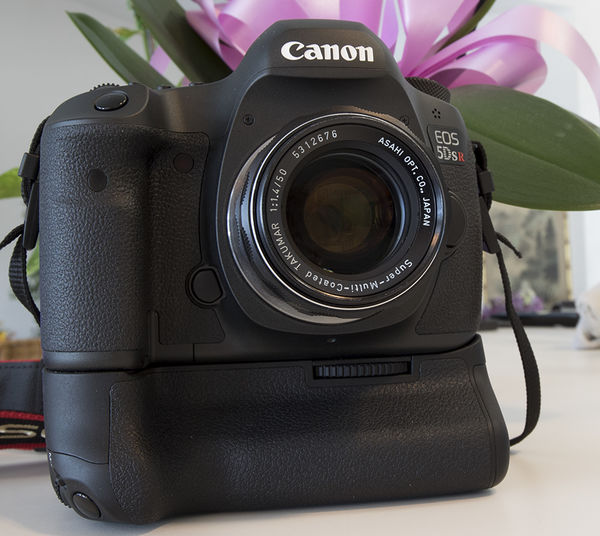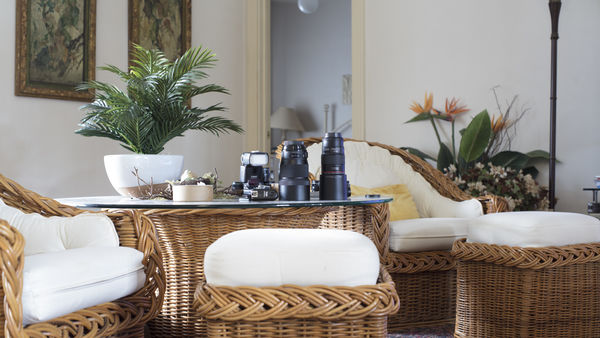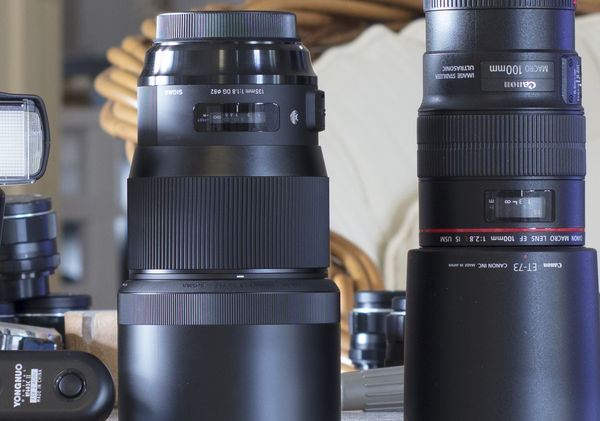Are Those Old Lenses from the 50's and 60's Any Good on a modern DSLR?
Sep 19, 2018 16:37:05 #
I have had this conversation more than once before but I see it asked periodically by other members, many people think that those old lenses will not work on their DSLR's and even if they could be mounted that they would not have the image quality able to perform to todays standards on a modern DSLR.
I am a collector and have been going through my collection getting ready to sell several lenses as I have duplicates and triplicates of many focal lengths. As I was doing this I mounted an old 50mm f/1.4 Pentax Takumar M42 lens to my 50mp Canon 5DSR, and took a pic just to remind myself why I fell in love with these old lenses in the first place. I did not have the opportunity to get out so I simply set some gear on a table across the room and took a pic. The wider shot of the table with gear is the full pic that the crop was taken from, this image has been down sized to post to the web, the image of the just the lenses is a 100% crop taken from the wider shot to get a closer look at the image quality of this old lens, the crop was taken before downsizing the image so it is at full resolution and will get bigger if downloaded. The only processing done on these images was minor EV adjustments and a little WB adjustment, no contrast or sharpening adjustments were made.
Anyway, I would love to hear other's thoughts on this lens.
I am a collector and have been going through my collection getting ready to sell several lenses as I have duplicates and triplicates of many focal lengths. As I was doing this I mounted an old 50mm f/1.4 Pentax Takumar M42 lens to my 50mp Canon 5DSR, and took a pic just to remind myself why I fell in love with these old lenses in the first place. I did not have the opportunity to get out so I simply set some gear on a table across the room and took a pic. The wider shot of the table with gear is the full pic that the crop was taken from, this image has been down sized to post to the web, the image of the just the lenses is a 100% crop taken from the wider shot to get a closer look at the image quality of this old lens, the crop was taken before downsizing the image so it is at full resolution and will get bigger if downloaded. The only processing done on these images was minor EV adjustments and a little WB adjustment, no contrast or sharpening adjustments were made.
Anyway, I would love to hear other's thoughts on this lens.
Sep 19, 2018 16:51:45 #
Sep 19, 2018 17:04:53 #
The main reason I have no desire to use old lenses is manual focusing. Today's cameras are not optimized for manual focusing, and I much prefer today's autofocus.
Sep 19, 2018 17:07:57 #
Some people like the vintage lenses for the image quality.
There is a Facebook group for this: https://www.facebook.com/groups/1510996062486122/
Look at the results by Kymarto on this thread:
https://www.uglyhedgehog.com/t-550788-2.html
There is a Facebook group for this: https://www.facebook.com/groups/1510996062486122/
Look at the results by Kymarto on this thread:
https://www.uglyhedgehog.com/t-550788-2.html
Sep 19, 2018 17:11:01 #
Since I grew up manually focusing some very fine lsenses since the early 60's I am not put off by manually focusing in todays equipment. That said, the AF era brought a lot of misinformation about the focusing qualities of legacy (old film) lenses. The advent of focus peaking in live view has leveled the playing field between old glass and new digital glass. The same differences still occur as in "good old glass" and "bad old glass" in legacy lenses, as now occurs with "good new glass" and "bad new glass" in digital equipment. Expense and diligence seem to be the key to judging. I shoot some premium old glass from film, that competes with the best new digital glass. The distinction is in knowing how to focus for the difference in the glass. I've seen some stinking digital glass outshot by old legacy glass.
Some of the very worst new digital glass in the market is marketed by Quantaray. No amount of great equipment, new or old, will deliver reliable image rendering or reliability from a Quantaray lens. Likewise, an iffy photographer can still shoot shit with the best old or new Zeiss Icon glass.
There is an extremely good level of glass new or old, within the realm of film, digital and clueless photographers, plus some pure shit glass as well.
Some of the very worst new digital glass in the market is marketed by Quantaray. No amount of great equipment, new or old, will deliver reliable image rendering or reliability from a Quantaray lens. Likewise, an iffy photographer can still shoot shit with the best old or new Zeiss Icon glass.
There is an extremely good level of glass new or old, within the realm of film, digital and clueless photographers, plus some pure shit glass as well.
Sep 19, 2018 17:41:59 #
FWIW, I think the 55 f2 SMC Takumar is the BEST of the (50's) Takumars !.....
I am a Pentax user from 1969 ....
..
I am a Pentax user from 1969 ....
..
Sep 19, 2018 17:49:53 #
imagemeister wrote:
FWIW, I think the 55 f2 SMC Takumar is the BEST of the (50's) Takumars !.....
I am a Pentax user from 1969 ....
..
I am a Pentax user from 1969 ....
..
I have all of the 50 1.4's, 55 1.8's and a Auto Takumar 55 f/2.2 with 10 aperture blades. My favorites just for their mechanical beauty are the presets, my 200 f/3.5 has 18 aperture blades and throughout the aperture range makes the perfect circle.
Sep 19, 2018 17:56:30 #
You need to put a Nikon in the picture. I bought a 55mm Nikkor from the 1960's on eBay and I use it on my Digital SLRs. I will put it up against any new lens. Another fun lens from the past is the Nikon 28-80 1:3'3 -5.6G. This was the Kitl Lens that came with the Autop Nikon film cameras. Less than $20. Ken Rockwell likes this one. Then there are the t mount/pre set lenses that will work on most cameras. All fun to use. - Dave
Sep 20, 2018 00:47:49 #
Blurryeyed wrote:
I have had this conversation more than once before... (show quote)
I certainly like them, I find them just as good as todays lenses!
Sep 20, 2018 01:25:09 #
imagemeister wrote:
FWIW, I think the 55 f2 SMC Takumar is the BEST of the (50's) Takumars !.....
I am a Pentax user from 1969 ....
..
I am a Pentax user from 1969 ....
..
I agree. I had an Asahi Pentax Spotmatic with the 50mm f/1.4 and the lens was very good. If you don't mind focusing manually, there's no reason you can't use older lenses. With many you will have to adjust your aperture manually, as well. No reason that shouldn't work.
Sep 20, 2018 03:10:59 #
Pablo8
Loc: Nottingham UK.
I have just bought a Sony body, so I can re-use my Leica 39 Screw lenses again. Also my Super Takumar lenses. I did use the Pentax lenses with adapter, on my Nikon DSLR cameras, but either no glass adapter and only close-focus subjects. Or adapter with glass to get infinity focus, and suffer what degradation there might be. Am anxiously awaiting the arrival (Ebay) of the adapters for these lenses to the Sony camera, all with infinity focus assured. I know it will revert to manual focus and manual stopping down etc., but I still do that with my 5x4 and Hasselblad cameras. There are NO 'Press Deadlines' for me now, I can take my time and enjoy (I hope) each magical moment. I could, of course go the whole hog with these Leica, and Pentax lenses. and shoot film with the original bodies. But that will mean chemicals/darkroom/ washing & drying prints. I used to enjoy that, because back then, there was no alternative method. I just want to embrace the best of both worlds.
Sep 20, 2018 04:19:47 #
Blurryeyed wrote:
I have had this conversation more than once before... (show quote)
There are four challenges: 1. Deciding what is worth searching for;
2. finding an old lens in good conditon, 3. finding an adapters to fit
the new mount, and 4. getting the AF camera to work with a manual
focus lens.
1.Good prime focus lenses go back a long time. As with any mature technology,
progress was rapid at first, but has now slowed.
Lenses are classified based on the degree to which the lens corrects aberrations:
Anastigmat: corrects for all seven types of first degree aberrations
Apochromat: twice as strict (requires correcting higher order aberrations)
Even higher grades are made for industrial and military use.
For camera lenses, some milestones are:
Anastigmat: Zeiss Protar, (1890, Paul Rudolph, Germany)
Leitz 50mm 3.5 Tessar-type (1925, Max Berek, Germany)
Apochromat: Leitz APO-Telyt-R 180mm f/3.4 (1975, West Germany)
Lens coatings are a 20th century invention. The first single-coated optics
were introduced by Carl Zeiss in 1935 and the first 2-layer in 1945.
Single coatings became common on high-end camera lenses in the 1950s
and multi-coatings in the 1970s. Since then, improvements have been made
to manufacturability and to durability, but not much to optical quality.
By the late 1970s, all the big Japanese camera makers were turning out
mutli-coated apocrhomatic optics for their pro model prime focus lenes.
Lower end models might have a bit more aberration, but all most were
pretty good.
Zooms were a different matter: focal ranges were narrow, and the image quality
ranged from OK to terrible--sometimes in different versions of the same lens!
Ken Rockwell calls the Nikon 43-86mm f/3.5 "the worst lens Nikkon
has ever made", but the second version (with the writing on the outside
of the focus ring) "just fine". I have the latter, and I agree: it's fine--
but not as sharp as Nikons equavalent prime focus lenses.
Zoom lens designs improved hugely in the 1980s, when computre
simiulation of optics became feasible. But the design of a zoom lens
is always a compromise (especially with regard to maximum aperture).
And zoom lens are much more complex to use then people realize
(how many of us know the sharpest aperture of whatever zoom we use
most often for each of its focal length settings?).
.
One other thing that changed since the 1980s that was not an improvement:
some lens diameters got smaller. For example, the Minolta filter ring size
went from 55mm to 52mm about the time AF was introduced, and lens
diameters shurnk accordingly. That's quite a big difference in light-gathering
ability (front surface area).
The mechanical constuction of most lines got noticably lighter and less
robust in the 1980s.
I have an old Miyama 1000 DTL (1968-1973) with a M42 screw mount
that I bought used on a whim. Thought I'd be annoyed by having to manually
stop-down in order to meter, but it's a breeze. The Miyama lenes are just Ok,
but fortuantely it will accept older Zeiss, Praktica, Pentax and Leica lenes.
And it sure beats having to deal with a plethora of different bayonet mounts.
It's a very simple camera, but that's basically all that I need.
I once started writing a "key" for visual identification of beyonet mounts on lenses.
When it reached 10 pages, I gave up.
Each manufactuer had to change its lens mount for coupled meter, then
again for auto-indexing (e.g.. Nikon), then again for AF, then again for motorized
lens AF
It just kept getting more and more complicated--with no benefit in
image quality. And now we're getting it again for mirrorless-again no
improvement in image quality (except perhaps for ultra-wide-angle lenses).
And the more mechanically complicated a lens is, the more likely it is
to stop working.
So if a manufactuer started off with 1 lens mount in 1970, today it on is 5th!
2. Old prime focus lenses can be excellent, but there are the usual problems
to watch out for: sticking apertures, internal dirt, fungus, loose or
excessively stiff rings. Even adjusting a lens for focus at infinity requires
a collimator.
Some lenses from the 1940s - 1970s are radio active: they contain
some thorium oxide glass elements. All thorium isotopes are weakly
radioactive, including alpha and beta emitters. This really only
poses a signficiant hazard if the lens is in an eyepiece (such as a
camera viewfinder or binocular)
3. As you probably know, adapters to fit short FFL lenses to longer FFL cameras
must contain a lens. It rarely is a coated lens. Adapters don't always fit
tightly and sometimes they won't lock correctly.
4. Getting a manual lens to work on an AF camera was a problem--
even within some lines of film cameras. For example, adapers allow
Minolta manual focus lenses to be attached to Maxxum alpha-mount
AF cameras, but the camera wouldn't operate unless you entered a secret
series of key strokes. (Forced obsolescence in action!)
As soon as cameras became embedded systems, it became possible
to add a line of code to the effect: "if old lens, halt". (The frist time I
heard of something like that was when Microsoft addeed code to
Windows 3.1 that prevented it from booting on DR DOS. It got
sued for that by Novell, which has purchased Digital Research.)
There are no ethics in the high tech industry that I ever noticed.
"Anything for a buck!" Unfortunately, today's cameras are as much
digital electronics as they are optics. For that reason alone--and
many others -- I would suggest using old lenses with the old
cameras they were made for.
Using old lenses with old cameras is a chance to get back to when
things were a little sane and a lot less complex. And you'll save a
bunch of money on batteries!
Sep 20, 2018 06:24:19 #
The Nikkor 50 f2 "H" lens is still one of my favorites. Very sharp, and has a recessed lens which both protects it without having to stick a filter on it, and as a shade to minimize flare. Can use it on my D5100 and D750
Sep 20, 2018 07:00:05 #
w00dy4012
Loc: Thalia, East Virginia
"4. Getting a manual lens to work on an AF camera was a problem--
even within some lines of film cameras. For example, adapers allow
Minolta manual focus lenses to be attached to Maxxum alpha-mount
AF cameras, but the camera wouldn't operate unless you entered a secret
series of key strokes. (Forced obsolescence in action!)"
Are you referring to Minolta Rokkor lenses on alfa mirrorless cameras? If so, the only thing you need use them, or any other manual lens, is to go into the menus and enable "release without lens", and an adaptor.
even within some lines of film cameras. For example, adapers allow
Minolta manual focus lenses to be attached to Maxxum alpha-mount
AF cameras, but the camera wouldn't operate unless you entered a secret
series of key strokes. (Forced obsolescence in action!)"
Are you referring to Minolta Rokkor lenses on alfa mirrorless cameras? If so, the only thing you need use them, or any other manual lens, is to go into the menus and enable "release without lens", and an adaptor.
Sep 20, 2018 07:15:26 #
Blurryeyed wrote:
I have had this conversation more than once before... (show quote)
There are a lot of fans of old lenses out there. Mathieu Stern on YouTube frequently posts about older lenses he has adapted. I imagine that on cameras with IBIS, old long lenses will find new devotees. In fact some believe the price for older lenses my go up as they become more desirable.
If you want to reply, then register here. Registration is free and your account is created instantly, so you can post right away.











